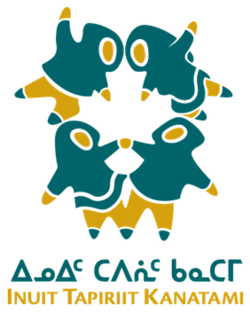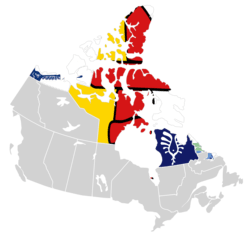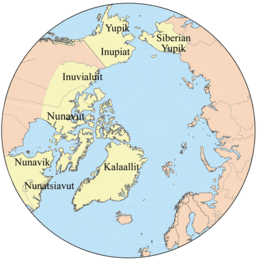Inuit Tapiriit Kanatami
Inuit Tapiriit Kanatami (Inuktitut syllabics: ᐃᓄᐃᑦ ᑕᐱᕇᑦ ᑲᓇᑕᒥ, meaning either "Inuit are united with Canada"[1] or "Inuit are united in Canada"[2]) is a nonprofit organization in Canada that represents over 60,000 Inuit.[3]
 | |
 Map of ITK showing the four constituent regions: Inuvialuit, Nunavut, Nunavik and Nunatsiavut | |
| Abbreviation | ITK |
|---|---|
| Formation | 1971 |
| Founder | Tagak Curley |
| Type | Inuit organization |
| Legal status | active |
| Purpose | advocate and public voice, educator and network |
| Headquarters | Ottawa, Ontario, Canada |
| Coordinates | 45°25′20″N 075°41′43″W |
Region served | Canada |
Membership | |
Official language | English, Inuktitut |
president | Natan Obed |
| Website | http://www.itk.ca |
History
It was founded in 1971 by Tagak Curley as the Inuit Tapirisat of Canada (or in English, Inuit Brotherhood) in Edmonton, Alberta.[4] It has been headquartered in Ottawa, Ontario since 1972.[5] It grew out of the Indian and Eskimo Association that was formed in the 1960s.
Goals
The organization represents Inuit living in four regions of the Inuit Nunangat (ᐃᓄᐃᑦ ᓄᓇᖓᑦ): Nunatsiavut in Labrador, Nunavik in Northern Quebec, Nunavut, and the Inuvialuit Settlement Region of the Northwest Territories and Yukon. It is headquartered in Ottawa. The status vis-à-vis the growing population of Inuit living outside the land claims regions remains unclear.
The aims of the organization is to preserve Inuit culture and the Inuit languages. To this end the ITK publishes the cultural magazine Inuktitut three times a year with content in Inuktitut (using Inuktitut syllabics), Inuinnaqtun (using the Latin alphabet), English, and French.
The organization also represents the Inuit before the Government of Canada and advocates publicly on the population's behalf.
Governance
ITK is governed by a board of directors and president. The board of directors consists of the presidents of the four regional land claims organizations: Nunavut Tunngavik Incorporated, Makivik Corporation, Nunatsiavut, and the Inuvialuit Regional Corporation. Each president is a voting member. The presidents of the National Inuit Youth Council (NIYC) and Inuit Circumpolar Council (ICC Canada) are non-voting members. Generally, the president of ITK does not vote at board meetings, except in case of a tied vote.[6] Any eligible Inuk can run for president. The board of directors votes for the president.
Rosemarie Kuptana, then the President of ITK, declared on July 27, 1995, that the Inuit of northern Quebec would boycott the October 30, 1995, referendum on sovereignty which failed to address self-government and land claim issues.[7]
Terry Audla was elected President of Inuit Tapiriit Kanatami on 6 June 2012.[8] He was succeeded by Natan Obed, who was elected with 54% of the vote on September 17, 2015, in Cambridge Bay, Nunavut.[9]
References
- postscript on Aboriginal Titles, Katherine Barber, Government of Canada Translation Service"
- "The National Voice for Inuit Communities in the Canadian Arctic". Inuit Tapiriit Kanatami. Retrieved 2020-02-04.
- Pound, Richard W. (2005). Fitzhenry and Whiteside Book of Canadian Facts and Dates. Fitzhenry and Whiteside.
- Inuit Tapiriit Kanatami (ITK)
- Inuit Tapiriit Kanatami Organizational Structure Archived 2012-02-04 at the Wayback Machine
- Pound, Richard W. (2005). Fitzhenry and Whiteside Book of Canadian Facts and Dates. Fitzhenry and Whiteside.
- News, Nunatsiaq (2012-06-07). "New national Inuit president strikes all the right notes". Nunatsiaq News. Retrieved 2020-02-04.
- News, Nunatsiaq (2015-09-18). "National Inuit org elects a new leader: Natan Obed". Nunatsiaq News. Retrieved 2020-02-04.
